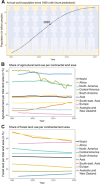Here comes the sun: How optimization of photosynthetic light reactions can boost crop yields
- PMID: 34962073
- PMCID: PMC9302994
- DOI: 10.1111/jipb.13206
Here comes the sun: How optimization of photosynthetic light reactions can boost crop yields
Abstract
Photosynthesis started to evolve some 3.5 billion years ago CO2 is the substrate for photosynthesis and in the past 200-250 years, atmospheric levels have approximately doubled due to human industrial activities. However, this time span is not sufficient for adaptation mechanisms of photosynthesis to be evolutionarily manifested. Steep increases in human population, shortage of arable land and food, and climate change call for actions, now. Thanks to substantial research efforts and advances in the last century, basic knowledge of photosynthetic and primary metabolic processes can now be translated into strategies to optimize photosynthesis to its full potential in order to improve crop yields and food supply for the future. Many different approaches have been proposed in recent years, some of which have already proven successful in different crop species. Here, we summarize recent advances on modifications of the complex network of photosynthetic light reactions. These are the starting point of all biomass production and supply the energy equivalents necessary for downstream processes as well as the oxygen we breathe.
Keywords: bioengineering; crop improvement; electron transfer; light reactions; photosynthesis; photosystem; stress tolerance.
© 2022 The Authors. Journal of Integrative Plant Biology published by John Wiley & Sons Australia, Ltd on behalf of Institute of Botany, Chinese Academy of Sciences.
Conflict of interest statement
The authors declare there are no conflicts of interest.
Figures







Similar articles
-
One crop breeding cycle from starvation? How engineering crop photosynthesis for rising CO2 and temperature could be one important route to alleviation.Proc Biol Sci. 2016 Mar 16;283(1826):20152578. doi: 10.1098/rspb.2015.2578. Proc Biol Sci. 2016. PMID: 26962136 Free PMC article. Review.
-
Photosynthesis research under climate change.Photosynth Res. 2021 Dec;150(1-3):5-19. doi: 10.1007/s11120-021-00861-z. Epub 2021 Jul 7. Photosynth Res. 2021. PMID: 34235625 Review.
-
Interaction between photosynthetic electron transport and chloroplast sinks triggers protection and signalling important for plant productivity.Philos Trans R Soc Lond B Biol Sci. 2017 Sep 26;372(1730):20160390. doi: 10.1098/rstb.2016.0390. Philos Trans R Soc Lond B Biol Sci. 2017. PMID: 28808104 Free PMC article.
-
Improving photosynthesis through the enhancement of Rubisco carboxylation capacity.Biochem Soc Trans. 2021 Nov 1;49(5):2007-2019. doi: 10.1042/BST20201056. Biochem Soc Trans. 2021. PMID: 34623388 Review.
-
Amelioration of plant responses to drought under elevated CO2 by rejuvenating photosynthesis and nitrogen use efficiency: implications for future climate-resilient crops.Photosynth Res. 2021 Dec;150(1-3):21-40. doi: 10.1007/s11120-020-00772-5. Epub 2020 Jul 6. Photosynth Res. 2021. PMID: 32632534 Review.
Cited by
-
Eustigmatophyte model of red-shifted chlorophyll a absorption in light-harvesting complexes.Commun Biol. 2024 Oct 29;7(1):1406. doi: 10.1038/s42003-024-07101-9. Commun Biol. 2024. PMID: 39472488 Free PMC article.
-
Enhanced abundance and activity of the chloroplast ATP synthase in rice through the overexpression of the AtpD subunit.J Exp Bot. 2022 Nov 2;73(19):6891-6901. doi: 10.1093/jxb/erac320. J Exp Bot. 2022. PMID: 35904136 Free PMC article.
-
Chloroplast ATP synthase: From structure to engineering.Plant Cell. 2024 Oct 3;36(10):3974-3996. doi: 10.1093/plcell/koae081. Plant Cell. 2024. PMID: 38484126 Free PMC article. Review.
-
Photosynthetic Adjustments Maintain Lettuce Growth Under Dynamically Changing Lighting in Controlled Indoor Farming Setups.Physiol Plant. 2025 Jul-Aug;177(4):e70405. doi: 10.1111/ppl.70405. Physiol Plant. 2025. PMID: 40650517 Free PMC article.
-
Rieske FeS overexpression in tobacco provides increased abundance and activity of cytochrome b6 f.Physiol Plant. 2022 Nov;174(6):e13803. doi: 10.1111/ppl.13803. Physiol Plant. 2022. PMID: 36259085 Free PMC article.
References
-
- Abbasi, A.Z. , Bilal, M. , Khurshid, G. , Yiotis, C. , Zeb, I. , Hussain, J. , Baig, A. , Shah, M.M. , Chaudhary, S.U. , Osborne, B. , and Ahmad, R. (2021). Expression of cyanobacterial genes enhanced CO2 assimilation and biomass production in transgenic Arabidopsis thaliana . PeerJ 9: e11860. - PMC - PubMed
-
- Abdel‐Ghany, S.E. (2009). Contribution of plastocyanin isoforms to photosynthesis and homeostasis in Arabidopsis thaliana grown at different copper regimes. Planta 229: 767–779. - PubMed
Publication types
MeSH terms
LinkOut - more resources
Full Text Sources
Miscellaneous

